
Here is a curated list of 18 side projects that became BIG! No, it didn’t happen overnight; instead, their tremendous success was largely due to their hard work and commitment.
From Gumroad and Product Hunt to Instagram and imgur, this list is jam-packed with ambitious founders who refused to give up.
Read about their success stories and get inspired on how you can do amazing things, and why working on a side project is just as important as the profession that you are devoting your time into.
Let’s get inspired, start small, keep working hard, and go BIG!!! ????
Table of Contents
Product Hunt
A platform to discover and share tech products
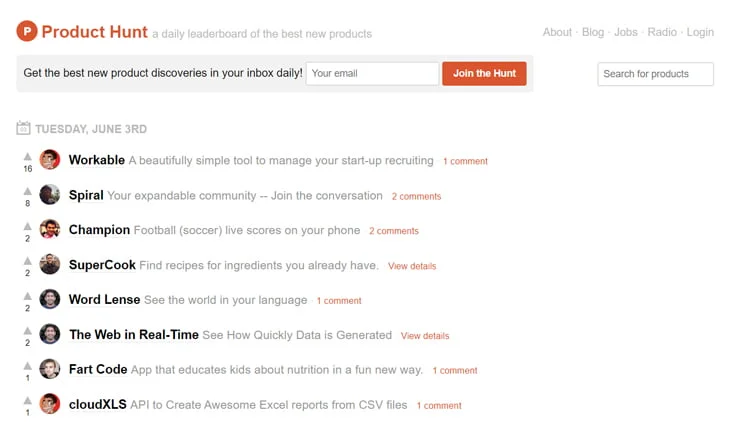
| 🚀 Launched | November 6, 2013 |
An email list and a group of good techie developer friends are sometimes all you need to hit the jackpot.
The same is true for Ryan Hoover, the founder, and CEO of Product Hunt, who started an email list of friends to share amazing new products, which subsequently inspired the development of the popular tech-discovery website, Product Hunt.
“I wasn’t an engineer, so I wasn’t going to invest the time or money in building an entire site from the start, but I could build an email list easily. I started one and invited a few dozen investors, founders, and other friends of mine who I thought might like this, and who had an inside track of what kind of tech products were cool.”
In a couple of years since its inception, Product Hunt has evolved into a community of thousands of monthly users. In 2013, it was sold to AngelList for $20 million.
A photo and video sharing social networking service
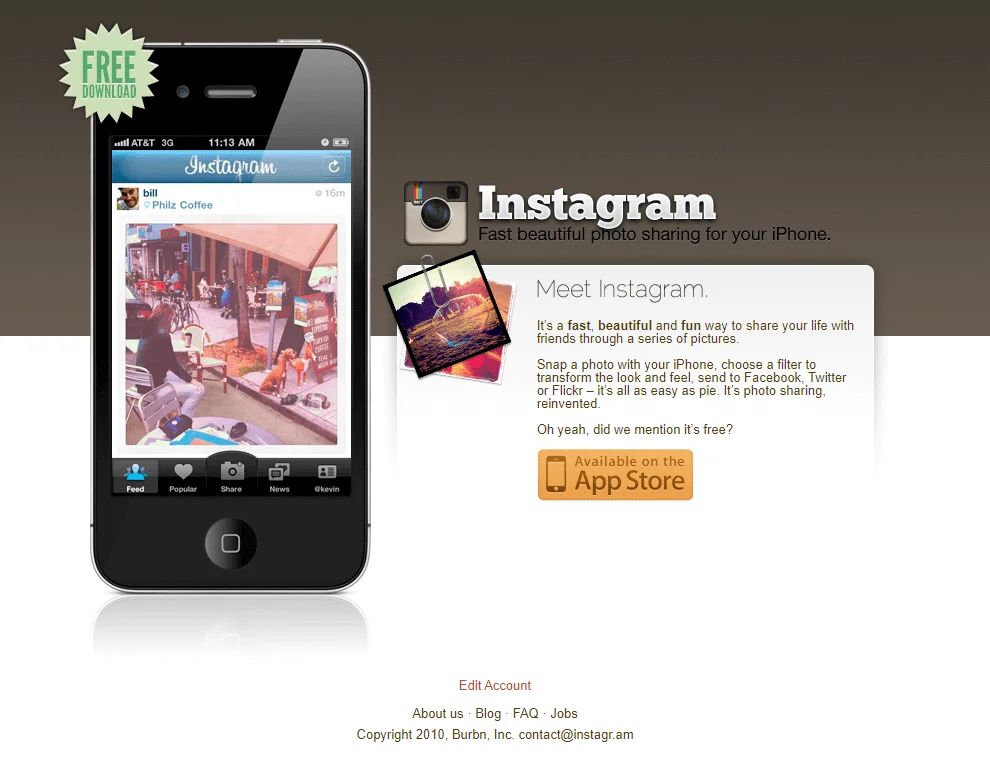
| 🚀 Launched | October 6, 2010 |
You don’t always need a degree to be successful. Sometimes you have the intelligence to educate yourself and achieve success! Want assurance? Continue reading…
Kevin Systrom, a 20-something-year-old Stanford graduate, worked as an excellent marketer during the day and spent his evenings learning how to code.
The self-taught programmer was inspired to create Burbn after noticing Foursquare’s recent success. Users of the app could discuss their plans, check into destinations, and post images.
Kevin met his acquaintances from venture capital firms and started discussing Burbn. As he continued to work on Burbn, Systrom closed a $500,000 seed funding round with Baseline Ventures and Andreessen Horowitz on March 5, 2010.
He put up a team that included Mike Krieger, the co-founder of Instagram, who was extremely knowledgeable in coding. He and Krieger’s decision to concentrate the app purely on photographs is when the magic began to unfold.
They gave it a new name: Instagram, a combination of the words “instant camera” and “telegram”.
Instagram quickly attained widespread popularity. When it first appeared for iOS in October 2010, Instagram received a lot of popularity, gaining 1 million users in just two months, 10 million in a year, and 1 billion by June 2018.
Facebook Inc. acquired Instagram in April 2012 for around $1 billion in cash and stock.
“For years, we’ve focused on building the best experience for sharing photos with your friends and family,” Mr. Zuckerberg wrote. “Now, we’ll be able to work even more closely with the Instagram team to also offer the best experiences for sharing beautiful mobile photos with people based on your interests.”
By October 2015 over 40 billion photographs had been uploaded on Instagram.
An online social media and social networking service
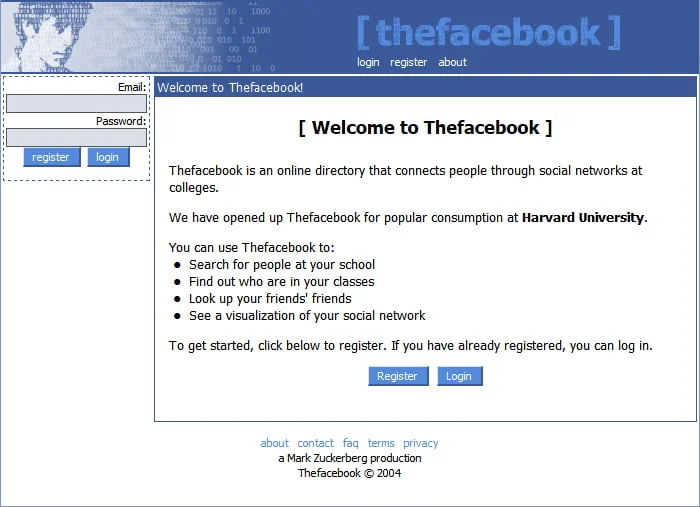
| 🚀 Launched | February 4, 2004 |
Why bouncing back is important? From one bad idea to a blockbuster, Zuck explains it all.
While enrolled at Harvard University, Mark Zuckerberg created the website “Facemash” in 2003. The website was similar to Hot or Not. The site was sent to several campus group listservs before being shut down by the Harvard administration a few days later.
As a result of FaceMash’s brief but successful operation, the founder of Facebook, Zuckerberg began to think about the advantages of developing a social network for everybody in the college.
Harvard College students and roommates Eduardo Saverin, Andrew McCollum, Dustin Moskovitz, and Chris Hughes joined Zuckerberg to launch “TheFacebook,” – a social networking website he had created to facilitate communication among Harvard students, that first appeared at thefacebook.com.
When it went live on February 4, 2004, Zuckerberg and his roommates were transfixed to their screens, watching as an estimated 1,200–1,500 of their fellow students signed on for the site within its first day. Facebook quickly grew, and by the end of the year, Facebook had 1 million users.
Peter Thiel had contributed $500,000, and Mark Zuckerberg had quit Harvard to take over the company’s new California headquarters. From there, Facebook became unstoppable. It grew to become not only an extremely profitable company but also one of the biggest organizations of the early 21st century.
Accel contributed $12.7 million to Facebook in May 2005, and Jim Breyer contributed an additional $1 million.
In July 2010, the business declared 500 million users. According to statistics, Facebook became the most popular website in June 2011 with 1 trillion page views. In May 2013, Facebook became a member of the Fortune 500 list for the first time. With 460 million shares traded on day one, the shares set a record for IPO trading volume.
Owner Facebook, Inc. changed its name to Meta Platforms, Inc. (or just “Meta”) in October 2021 as it shifted its emphasis to creating the “metaverse” The name of the social networking service Facebook remains unaffected by this modification.
As of December 2022, Facebook claimed 2.96 billion monthly active users and ranked third worldwide among the most visited websites.
Facebook was the most downloaded mobile app in the decade of 2010.
Gumroad
An e-commerce platform that allows creators to sell products directly to their audience

| 🚀 Launched | January 1, 2011 |
How long is a weekend? Sometimes, just one Big Side Project.
Sahil Lavingia is a self-taught developer who resides in San Francisco, California.
The creators of Pinterest contacted Lavingia during his first semester at USC. He left school and joined the site as one of its founding members.
At the height of its popularity Lavingia left Pinterest to establish his own business.
Sahil Lavingia launched Gumroad in 2011. Over the course of one weekend in 2011, Sahil created the initial version of Gumroad. Gumroad enables creators to market their digital goods to their audience directly.
“I was at home on a Friday night in Palo Alto and I really wanted to learn realistic icon design,” Lavingia says. “So I sat down at my computer and worked on this photorealistic pencil I’d designed in Photoshop. It took me around four hours and I thought, ‘Wait a sec–if I follow a bunch of designers on Twitter, a bunch of designers probably follow me, and I should try to sell this. I could just put it up for a buck, and if you buy it, I’m gonna do it again.”
While remaining the only member in Gumroad, Lavingia announced in February 2012 a $1.1 million seed round from a distinguished group of investors that included Accel, Chris Sacca, Max Levchin, SV Angel, Josh Kopelman, Seth Goldstein, Naval Ravikant, and Danny Rimer.
In his blog, he says, “It doesn’t matter how amazing your product is, or how fast you ship features. The market you’re in will determine most of your growth”.
Three months later, it was revealed that Kleiner Perkins Caufield & Byers (KPCB) had led a $7 million Series A financing for Gumroad. Former Twitter engineering head Michael Abbott made the investment as a KPCB partner for the first time.
Surely he has been one of The Most Interesting Teenager In Silicon Valley.
Etsy
An e-commerce company focused on handmade or vintage items and craft supplies
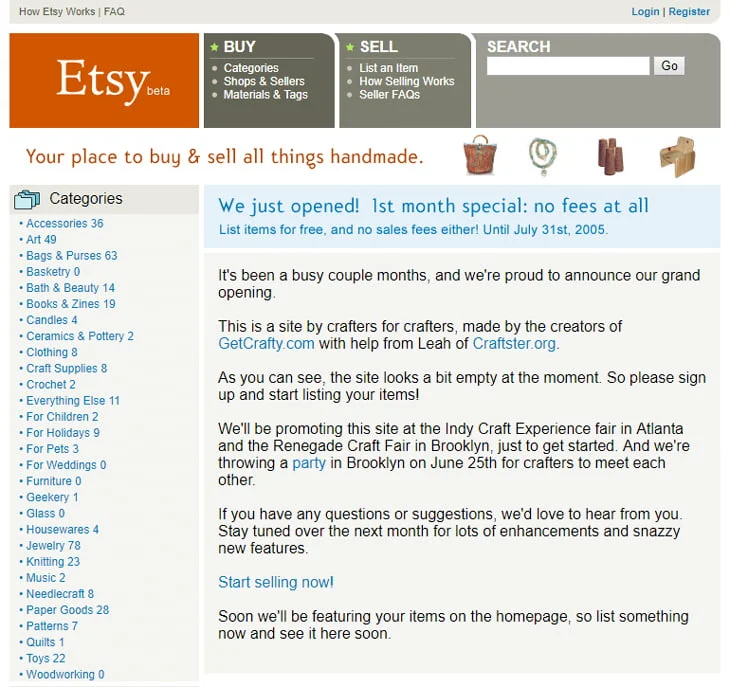
| 🚀 Launched | June 18, 2005 |
I heard art is dead.
Is that so? But I can, for sure, tell crafts and vintage items aren’t dead yet, and Etsy is the living proof of that.
Robert Kalin, Chris Maguire, and Haim Schoppik’s small business, iospace, introduced Etsy in 2005. Later, Jared Tarbell also joined the group.
Maria Thomas, a former executive at NPR, joined Etsy in 2008 as COO, rose to CEO, then resigned in December 2009. From December 2009 to July 2011, Robert Kalin was back in charge as CEO.
Over 100 million goods were available in Etsy’s marketplace as of December 31, 2022.
Despite how catchy the name is, many have frequently questioned what it means.
Rob Kalin, the company’s founder, ultimately disclosed the answer in a Reader’s Digest interview from January 2010:
“I wanted a nonsense word because I wanted to build the brand from scratch. I was watching Fellini’s 8 ½and writing down what I was hearing. In Italian, you say ‘etsi’ a lot. It means ‘oh, yes.’ And in Latin, it means ‘and if.’”
Etsy generated $13.3 billion in gross merchandise sales (GMS) on the platform in 2022. A total of US$2.6 billion was made in 2022.
craigslist
A company that runs community forums, classified ads, and information services
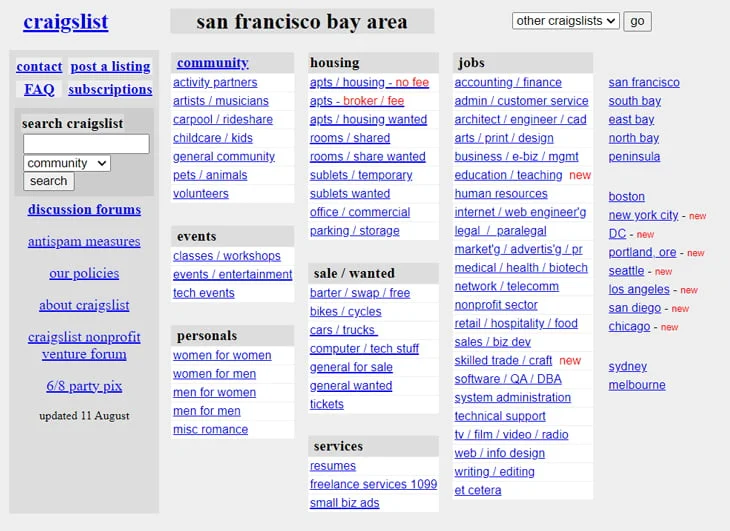
| 🚀 Launched | January 1, 1995 |
A fun project might be a healthy hobby to indulge in after a busy 9 to 5 schedule, but is it worthwhile investing the time and effort?
The founder and CEO of craiglist, Craig Newmark, presented all the whys and hows.
Craig was wise enough to identify the requirements of the locals after becoming frequent at local programming events. He targeted the audience and assisted them by creating an email list to keep everyone informed. The list gained popularity quickly, and people ultimately began utilizing it for purposes more than simple meetups.
The email list was shut down by Craig due to the excessive traffic, and everything was then moved to the Craigslist website (stylized as craigslist), and the rest is history!
Craig Newmark was named one of the 100 most influential people in the world by Time magazine in 2005. Craigslist’s net income as of today is $500 million.
imgur
A website that hosts and allows users to share images
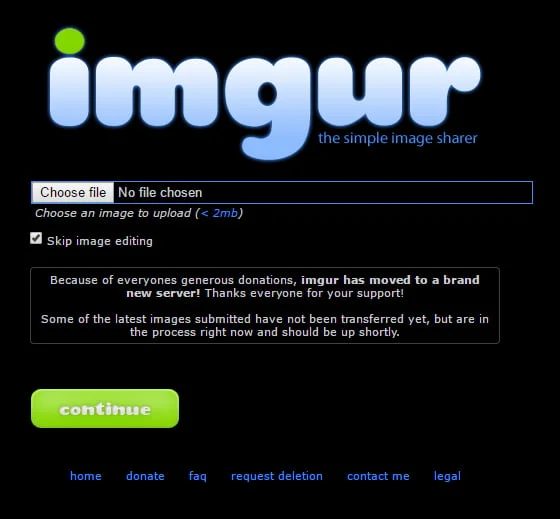
| 🚀 Launched | February 23, 2009 |
Another day, another side project becoming BIG. Have you started working on yours already? Because If Not Now, Then When?
imgur was developed in 2009 by Alan Schaaf as a side project while he was a student at Ohio University. Imgur is stylized as imgur and is pronounced “imager.” He initially created it as a type of gift for Reddit users.
Schaaf posted on the social news website Reddit:
“My Gift to Reddit: I created an image hosting service that doesn’t suck. What do you think?
I got fed up with all the other image hosts out there so I made my own. It doesn’t force you to compress your images, and it has neat things like crop, resize, rotate, and compression from 10-100. It’s my gift to you. Let’s not see any more imageshack/photobucket around here 😉 “
imgur quickly went viral, going from a thousand hits per day to a million in the first five months. It currently ranks in the top 100 websites in the United States. In 2013, imgur supported more than 2 billion daily image views and had 100 million monthly users.
The social media network gained a further boost in 2015 when Andreessen Horowitz invested $40 million in it.
On September 27, 2021, imgur published a public announcement declaring that they had been acquired by MediaLab AI, Inc., a holding company for online enterprises. After a brief period, in January 2022, Alan Schaaf made a successful exit from the company.
HubSpot
A cloud-based CRM designed inbound marketing and sales software that helps companies for inbound marketing, sales, and customer service
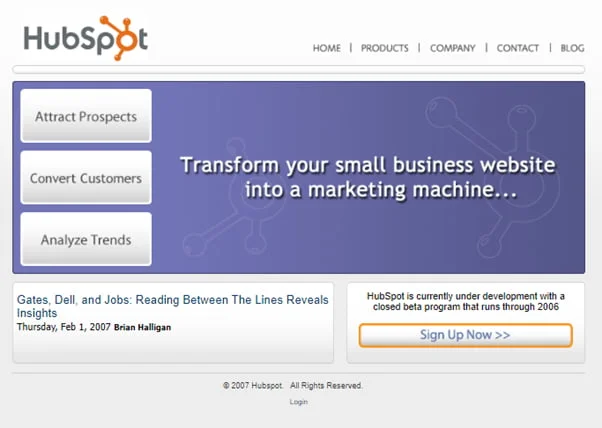
| 🚀 Launched | June 1, 2006 |
Start from a blog, work hard, stay consistent, and go big!
Brian Halligan and Dharmesh Shah, as fellow graduate students at Massachusetts Institute of Technology in 2004, observed a change in consumer behavior that indicated consumers were no longer receptive to unfavorable methods of gaining their attention.
In response to that study, the blog hubspot.com was launched in 2006.
The co-founder Dharmesh said, “A tiny blog with no budget generated more traffic than companies with professional marketing teams.”
The blog further describes the fact that “HubSpot was based on the “inbound” philosophy, which asserts that consumers only want to be assisted and don’t want to be bothered by marketers”.
According to Forbes, HubSpot started out targeting small companies but “moved steadily upmarket to serve larger businesses of up to 1000 employees.”
The company reported revenues of $1 billion in 2021.
In September 2021, HubSpot announced Yamini Rangan as their new CEO, while Brian Halligan became the Executive Chairman.
Today, HubSpot is a multi-million dollar startup that continues to empower businesses around the world.
A visual search engine for ideas such as recipes, home and fashion inspiration, and more

| 🚀 Launched | December 1, 2009 |
The idea that failed could be the foundation of the idea that would succeed. Study the results, reframe the concept, remain consistent, and dream BIG!
The founders of Pinterest are Evan Sharp, Paul Sciarra, and Ben Silbermann. The idea for Pinterest came from a previous app called Tote, developed by Ben Silberman and Paul Sciarra as a digital alternative for print catalogs. Tote experienced business difficulties, which were mainly caused by problems with mobile payments.
However, Tote users were gathering big collections of their favorite things and sharing them with other users. Silberman noticed the behavior and moved the company’s focus to establish Pinterest, which allowed users to make collections of various products and share them.
Pinterest’s development started in December 2009, and in March 2010 the website unveiled its prototype as a closed beta. The website received 10,000 visitors nine months after it went live.
The website reached 25 million unique monthly users by the end of August 2012, making it the quickest independent social networking platform to 20 million members.
With more than 200 million users, Pinterest is currently valued at $12 billion.
A micro-blogging social network that allows posting short messages called tweets
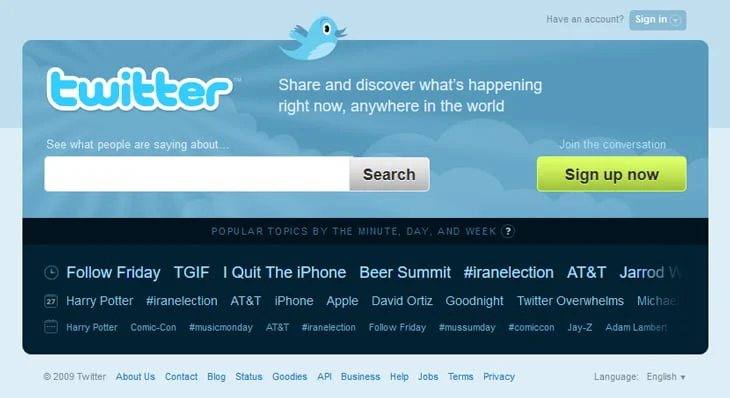
| 🚀 Launched | July 15, 2006 |
What’s the best course of action if you have everything planned out but the concept was introduced to the market from a stronger platform?
Brainstorm!
In 2005, Jack Dorsey was a programmer for the podcasting network Odeo when Apple surprised the industry by adding podcasts to iTunes. As soon as that occurred, the Odeo founders realized their company was in peril and held a brainstorming session to consider alternative business ventures.
Wouldn’t it be amazing, wondered Jack Dorsey, if there existed a mobile social network that would let your friends know what you were doing in real time? When Dorsey presented his plan for Twitter, his superiors approved it. While they continued their podcasting efforts, they offered Dorsey permission to work on his side project, twittr – a site that allows users to submit short status updates.
As Jack stated when he released his sketch of the service he had in mind, “I’m happy this idea has taken root; I hope it thrives.”
It changed its name to Twitter and became its own corporation in 2006, with Dorsey serving as the CEO.
The founder of Twitter, Jack Dorsey has explained the origin of the “Twitter” title:
“…we came across the word “twitter”, and it was just perfect. The definition was ‘a short burst of inconsequential information’, and ‘chirps from birds’. And that’s exactly what the product was.”
By 2012, there were more than 140 million active users tweeting 340 million tweets per day. It was among the top ten most visited websites in 2013.
By the start of 2019, Twitter had more than 330 million monthly active users.
Elon Musk, a business tycoon, purchased Twitter on October 27, 2022, for US$44 billion and took ownership of the social media network.
Elon changed the name of the website from Twitter to X on July 23, 2023. Musk revealed in a tweet that he wants to make X into an “everything” app.
“Twitter was acquired by X Corp both to ensure freedom of speech and as an accelerant for X, the everything app. This is not simply a company renaming itself, but doing the same thing. The Twitter name made sense when it was just 140-character messages going back and forth – like birds tweeting – but now you can post almost anything, including several hours of video.”
Sorry, did I say tweet? Oops, I guess Musk X-ed the reason sounds right? Ain’t it, Musk?
GitHub
A code hosting platform for version control and collaboration

| 🚀 Launched | April 10, 2008 |
Work environment gettin’ tough on you? You landed on a page about side projects? Maybe, it’s a sign, you start one!
Chris Wanstrath and PJ Hyett, co-founders of GitHub, were developing Ruby on Rails websites for CNET, a technology news and review site. Since convincing the coders to update the open-source code proved difficult and time-consuming, they opted to create their own repository.
With GitHub.com, anyone may comment on your code, add to it, and help it grow into something greater. The secret lies in the fact that it decentralizes programming, providing everyone with an innovative method of control.
Thomas Dohmke, the CEO of GitHub says “We keep fighting for the rights of open-source developers because we believe that open source is fundamental to achieve human progress.”
GitHub claims to be the largest host of source code in the world as of May 2019, with over 37 million members and more than 100 million active repositories (including at least 28 million public repositories).
Microsoft acquired Github in 2018 for $7.5 billion.
GitHub, Inc. has been in business since 2007 and is headquartered in San Francisco.
Slack
A business messaging app that combines people, conversations, data, and your favorite apps together in a virtual space
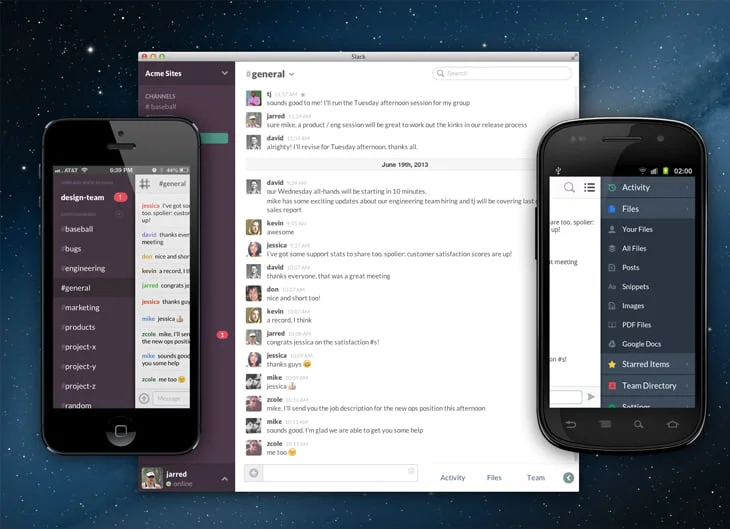
| 🚀 Launched | August 1, 2013 |
Ever wished you could create a billion-dollar business without spending any money on advertising? Is that even possible?
Slack is the inspiration! Stewart Butterfield, the founder of Slack, originally intended to create a game. For a gaming company, Stewart Butterfield hoped to develop a communications platform for the massively multiplayer online role-playing game (MMORPG) industry. Instead, Glitch was established, which, despite employing several strategies, failed.
“It was so weird and unfamiliar to people,” says Butterfield.
The group, meanwhile, did not allow their setback to define them. While creating the game, the Glitch team began working on an internal chat system as a side project. Every employee would work on it in their free time. Later, Glitch evolved into Slack, the fastest-growing startup in history and the most widely used productivity and chat platform in the world without investing any marketing expenses.
It is primarily intended for use in the office, where a lot of people have utilized it to establish social groups. In less than two years, Slack was valued at over $2.8 billion. When they last published their sales figures in 2015, Slack had roughly 500,000 paying subscribers and 7 million daily users.
Slack was purchased by Salesforce in July 2021 for an astounding $27.7 billion!
Unsplash
Stock photography database
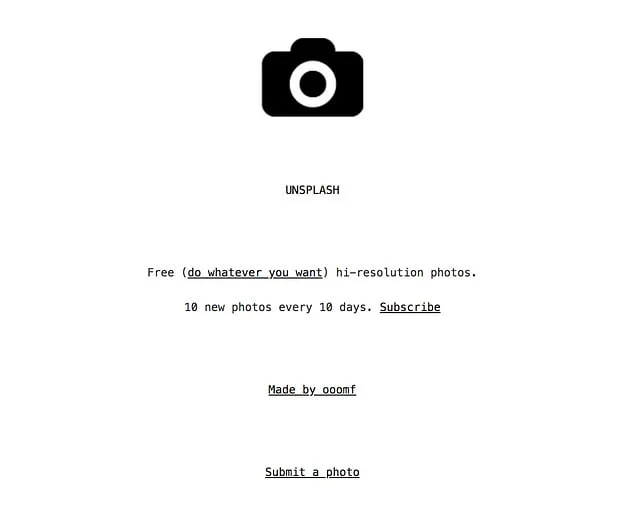
| 🚀 Launched | May 29, 2013 |
History witnesses the success of every side project that did not compromise on solving issues and showed no signs of giving up.
Unsplash started its journey in 2013 as a Tumblr blog. It was created as a spin-off from the Montréal design studio Crew when the business engaged a local photographer to take some photos for a project and thought they should do something with the unusable surplus photos. Cho later posted the photoshoot outtakes from his business on Tumblr and allowed anybody to use them however they liked. Solved problems of millions out there who were tired of bad quality, watermarked, low-res, or expensive stock photography.
They launched on Hacker News and were voted the most popular story. On its first day, Unsplash attracted more than 50,000 visitors. This side project turned into its own company after saving Crew from nearly running out of money. To solely focus on Unsplash, the Montréal startup sold Crew in 2017.
Unsplash has developed into a platform with millions of users, millions of free photos, and thousands of partner integrations. On an international scale, Unsplash has seen more than two billion photographs downloaded this year.
Unsplash was acquired by Getty Images in March 2021.
“We could not be happier to welcome Unsplash to the Getty Images family,” said Craig Peters, CEO of Getty Images. “The Unsplash team share our values and share our vision of enabling global creativity and communication. We are impressed by what the Unsplash team and community has built and we look forward to supporting their continued development.”
Cho will continue to lead Unsplash while it continues to function as a separate brand and part of Getty Images.
“I’m so proud of what the Unsplash community and team has created,” said Mikael Cho. “And it’s only the beginning. This partnership is an important milestone for Unsplash, but our mission of photos for everyone remains unchanged. We are very excited to partner with Getty Images to move the industry forward together.”
According to Crunchbase, Unsplash has raised more than $31.3 million to date.
Trello
The visual tool that empowers your team to manage any type of project, workflow, or task tracking
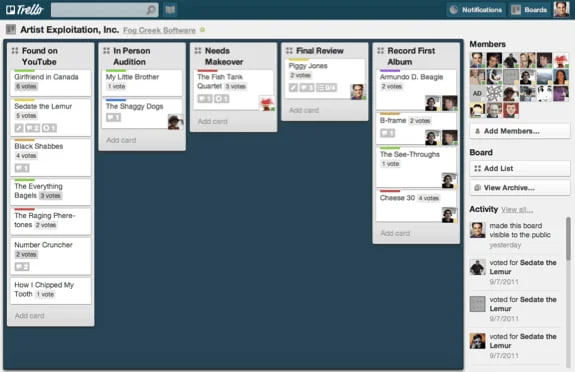
| 🚀 Launched | September 13, 2011 |
Little did they know that solving high-level planning issues is not the need of one company but several out there!
Fog Creek Software launched the internal project Trellis in an effort to address the organization’s significant planning issues. A prototype concept was presented in January 2011 to address problems with high-level planning. Development quickly shifts to a full-time mode. The project was later renamed Trello.
The application was listed as one of “The 7 Coolest Startups You Haven’t Heard of Yet” in the September 2011 issue of Wired magazine.
In 2014, it raised US$10.3 million in funding from Index Ventures and Spark Capital as mentioned in the Wall Street Journal, edition July 2014.
Trello passes the 500,000-member mark in the summer of 2012. Atlassian paid $425 million to acquire Trello in 2017. Currently, millions of people from all over the world use this SaaS product.
In March 2019 Trello declared 35 million users, while in October 2019 it reported 50 million users.
Twitch
An interactive live-streaming service
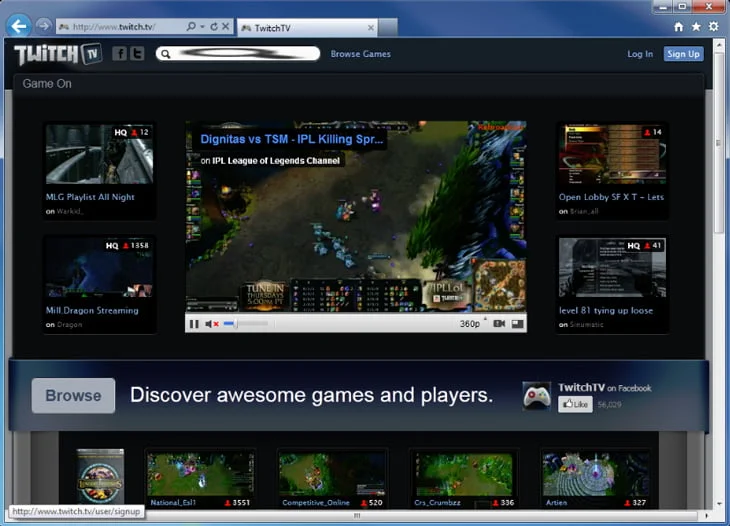
| 🚀 Launched | June 6, 2011 |
What can be learned from Twitch’s successful development: Know what you want, but also pay attention to what the audience wants.
Several content categories were established when Justin.tv was first founded in 2007 by Emmett Shear and Justin Kan, two recent Yale grads. The most popular category on the site by far was gaming, which expanded remarkably quickly.
TwitchTV was launched in June 2011 after the company chose to separate its gaming content.
On June 6, 2011, a public beta test was officially launched. Since then, Twitch has averaged over 35 million unique visitors each month.
Twitch has received major venture capital funding, including US$15 million in 2012, and US$20 million in 2013.
The website received 45 million unique visitors in October 2013 and was ranked as the fourth-largest source of peak internet traffic in the US by February 2014. When Justin.tv was shut down in August 2014, the parent company was renamed Twitch Interactive to reflect the change in direction.
The same year Twitch was acquired by Amazon for US$970 million. Twitch acquired Curse LLC, an operator of online video game communities, in 2016.
In October 2020, it had 34.5 million monthly broadcasters and 30 million daily active users, with 2.5 million concurrent viewers on January 11, 2021.
Clancy took over as CEO of Twitch in March 2023 after Emmett Shear, the former CEO and co-founder of Justin.tv, announced his resignation after 16 years with the company.
“In October 2006 we started working on live video for the internet. That became Twitch. More than 16 years later, I’m now a father and ready to move to my next phase of life. I wrote a blog post, but the short version is: thank you so much to everyone who built this with me.”
— Emmett Shear (@eshear) March 16, 2023
Buffer
A user-friendly social media management solution
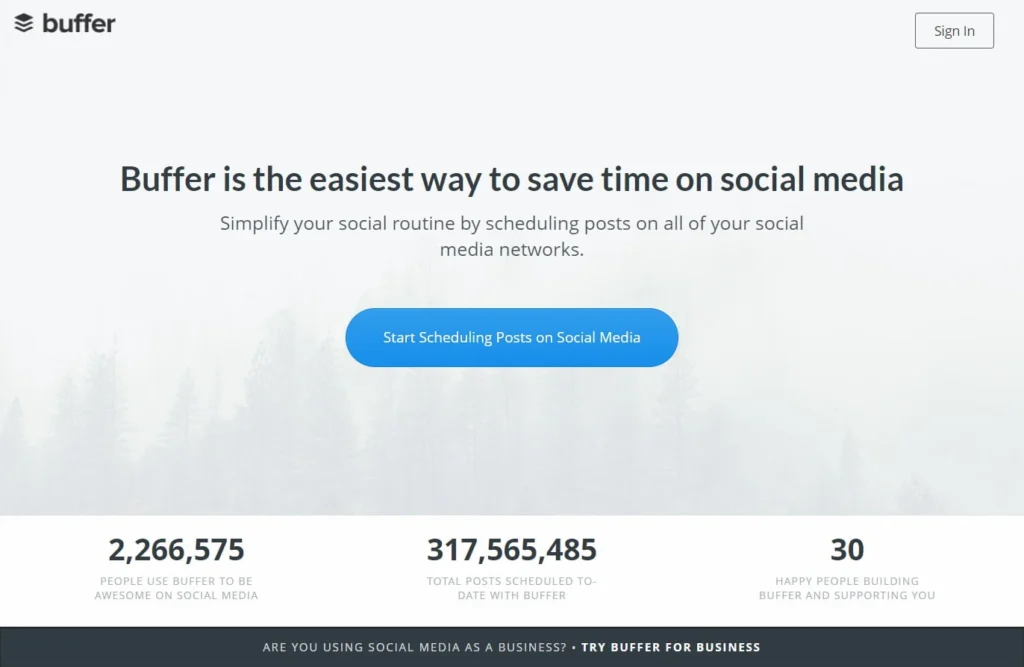
| 🚀 Launched | November 30, 2010 |
Can I try publishing a landing page to see if I can drive enough traffic?
Why not?
Joel Gascoigne, Buffer’s CEO, built and designed the first application software version after obtaining a sufficient mass of registrants on the landing page.
“It’s been ten years since I launched the first version of Buffer. What started as a landing page to gauge interest, and then a very basic product that I worked on alone, has become so much more. Buffer is now a leading social media management platform and a team of nearly 90 people working remotely worldwide, with our own approach and culture,” Joel Gascoigne.
Maintaining a high-quality blog has also greatly helped them in keeping their audience engaged. The company’s success is primarily due to a well-established marketing plan. That is exactly what Buffer helps other businesses with!
The company’s total revenue was reported to be $17.50 million in the fiscal year that ended in 2018. In 2019, they had a total of 74,825 customers.
Buffer has raised $4 million in investment, has over 4.5 million registered users, and earns over $16 million in annual income.
Udemy
An education technology company that provides an online learning and teaching platform
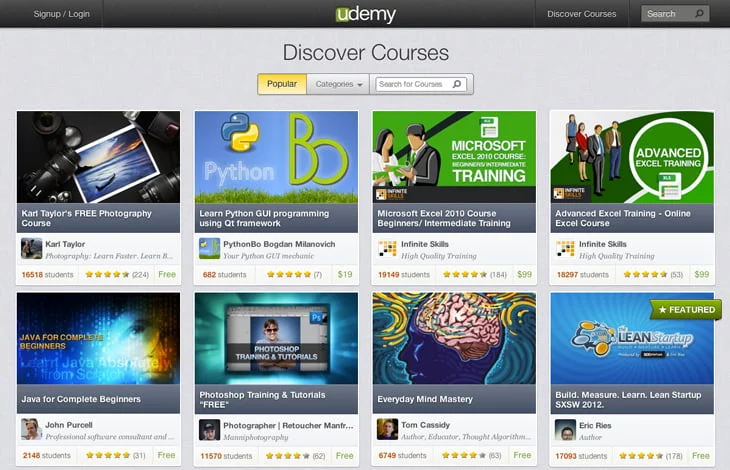
| 🚀 Launched | May 11, 2010 |
Education has never been easier. From a virtual classroom to a platform offering thousands of courses all around the world, Udemy has definitely hit the home run!
Eren Bali and Oktay Caglar, the founders of Udemy, created software for a real-time virtual classroom in 2007. They recognized the potential of making the product free for all, and two years later came to Silicon Valley to start a company. Udemy was launched by Eren Bali, Oktay Caglar, and Gagan Biyani in May 2010.
Udemy is a combination of the words “you” and “academy.”
According to Gayan Biyani, the founder of Udemy, the reason why Udemy’s requests for venture capital funding were turned down 30 times was largely because investors weren’t confident enough in the business to pull the trigger. So they opted to self-develop the product and established Udemy—”The Academy of You”—in May 2010.
In a short period, Udemy had around 10,000 registered users and 1,000 teachers had produced about 2,000 courses.
They decided to try another round of financing based on this positive market response, and by August they had raised $1 million in venture finance.
Groupon investors Eric Lefkofsky and Brad Keywell, as well as 500 Global (formerly 500 Startups) and MHS Capital, led an additional $3 million Series A fundraising round in October 2011.
Udemy raised $60 million from Naspers Ventures in June 2016, then followed up on a $65 million Series D round of funding in June 2015. Udemy further raised $50 million in November 2020 at a $3.25 billion value, with Tencent Holdings as the lead investor.
The site had 62 million users as of March 2023, taking more than 210,000 courses. With over 830 million course enrollments, Udemy provides more than 70,000 educators instructing courses in approximately 75 languages.
Udemy is headquartered in San Francisco, California.
Groupon
A website that offers cheap coupons for a variety of goods and services

Coupons … who doesn’t like coupons … But what about bringing a bunch of friends for a group discount? Who could have imagined that? Well, Andrew did.
In 2006, founder Andrew Mason’s disappointment with trying to terminate a mobile phone contract led to the creation of Groupon. Mason believed that there must be a method to utilize the collective bargaining power of a large number of people.
“I just thought, There has to be a large number of people with these same problems, and if we were united in some way, we could leverage our collective power”, says Andrew.
Mason established the Point, a website aimed at uniting people behind a cause, in 2007. It didn’t really take off in Chicago until a group of users decided to make saving money their cause. In order to earn a group discount, they searched for other individuals who would purchase the same item.
The concept captivated the interest of his former employer, Eric Lefkofsky, who contributed $1 million to its development. In November 2008, Groupon began operations.
The name of the online shopping site, Groupon, is a combination of the words “group” and “coupon.”
The company was worth $1.35 billion in April 2010.
The company went public on November 4, 2011. Since Google’s IPO in 2004, it was the largest IPO by an Internet company.
By the end of March 2015, Groupon offered more than 425,000 active offers in 48 countries, served more than 500 cities worldwide, and had almost 48 million active customers.